Lithops: species, reproduction and care
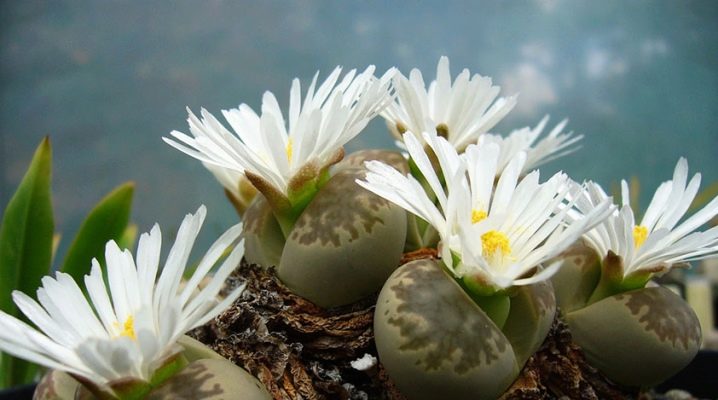
A very large number of wild plants have become decorative, that is, those that can be grown even on your windowsill. Thanks to this, you can decorate and play up any interior in an original way. Some of the most unusual plants that are suitable for decorating your apartment are lithops.
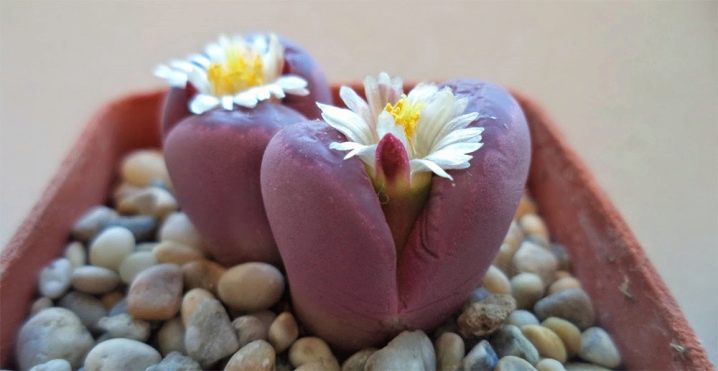
Description
The name "lithops" comes from the combination of two words of the Greek language, translated as "stone" and "appearance, image". When literally translated, "the appearance of a stone" is obtained. In modern language, the second name of the plant is "living stones". The Greeks gave this name to small flowers for a reason. In appearance, they look like small flat pebbles.
This appearance was formed in the course of evolution, since the "stone" grows in harsh desert conditions, where everything that cannot protect itself or disguise itself as the environment is eaten. Lithops are practically indistinguishable from stones, and it is possible to recognize a plant in a small pebble only during the flowering period, when a flower blooms in the middle of the "pebble", in the hollow between two thick leaves.


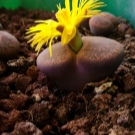
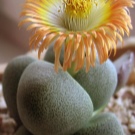
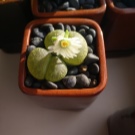
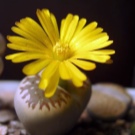
Lithops is a succulent plant that belongs to the Aizov family (mesembryanthenic). The largest population of the plant is found in the deserts of Namibia, South Africa and Botswana.
The flower has two parts - aboveground (outer) and root. The aerial part consists of two large thick petals, which form two halves of one whole. It is the connecting petals that give the plant the resemblance to a small pebble. The leaves are porous to make it easier to store moisture and sunlight in case of a dry season. Also, with the help of pores, the process of plant photosynthesis takes place. For the same reason, the leaves are so massive, because the thicker this part, the more water they can accumulate.
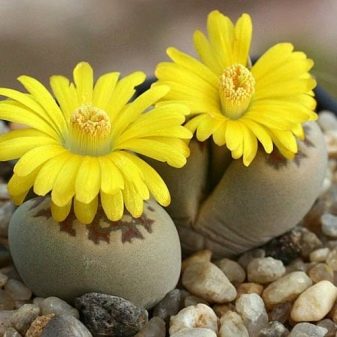
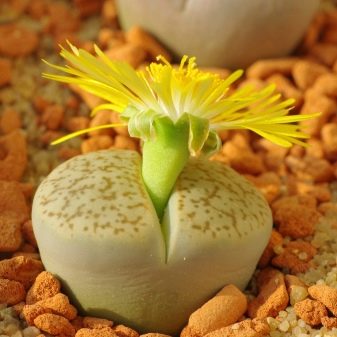
There is a shallow crevice between the petals, from which a flower and new petals grow. The underground part of the plant consists only of the root. It is noteworthy that the root of these plants grows deeper and can reach several meters. The maximum plant size, both in height and in width, can be up to 5 centimeters. The color of the inflorescence, the color and pattern of the petals, the aroma - it all depends on the variety of the flower, on its habitat, therefore, the description of the color of the plant will depend mainly on which subspecies you choose for yourself.
Despite the fact that lithops are very beautiful, it is worth remembering that these exotic succulents are poisonous and not edible, which means they need to be protected from small children and pets.
For adults who are not going to eat lithops, they are absolutely safe.
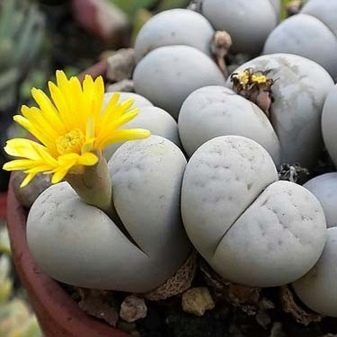
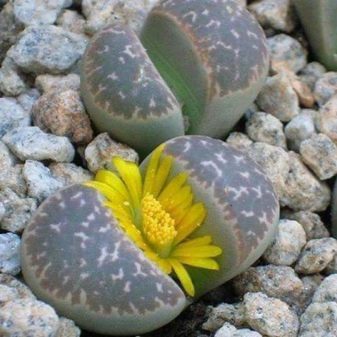
Views
There are many types of "living stones". At the moment, about 35 varieties are known, but it is quite possible that in a few years there will be even more of them. This is a big plus, because in the interior it will be possible to arrange several types, forming a kind of exotic mix. The most popular species names for this plant are Leslie and Aucamp.
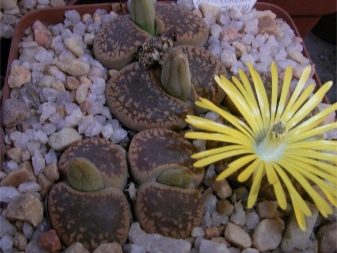
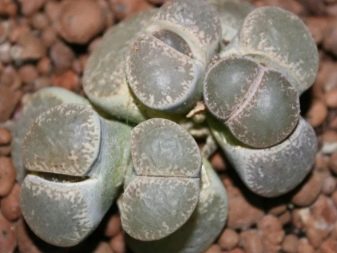
The Leslie variety was discovered back in 1908. It got its name from the name of the person who discovered it. Leslie leaves range from pinkish-brown, coffee-with-cream color to ocher-greenish. There are also all shades of pure gray in the petals.
There is a complex pattern on the leaves that is unique to each plant.
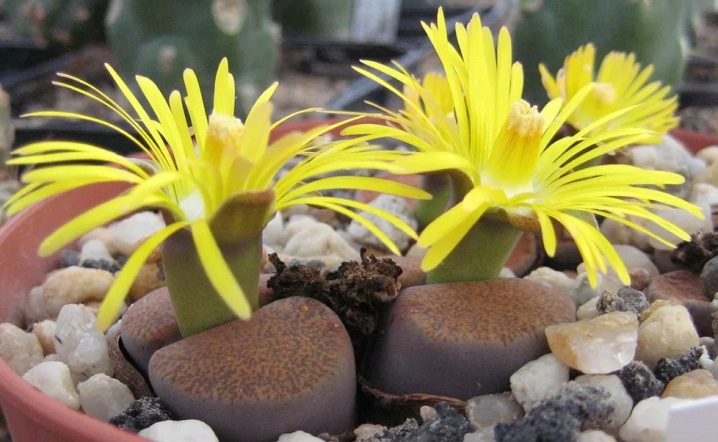
Leslie has a beautiful flower of intense yellow (or in some cases white) color. The flowering period is in September and October. Flowering lasts only a few days. The blossoming flower has a very unobtrusive and delicate aroma. However, it blooms only in the third year after sowing the seeds. In size, "Leslie" is one of the smallest species of lithops. Its leaves spread out only two centimeters.
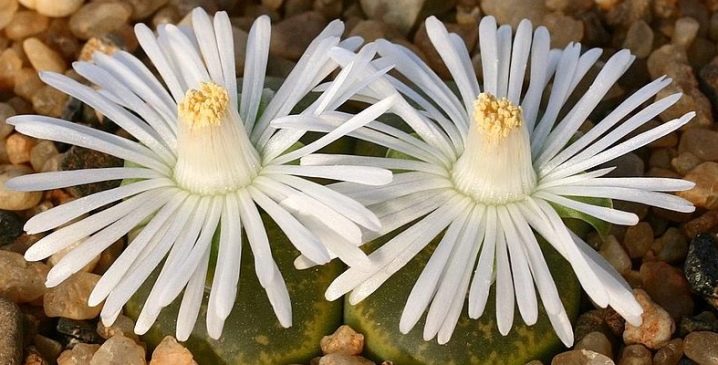
There are at least two Leslie hybrids with other lithops subtypes. For example, the Albinica variety, which belongs to the Leslie type, is distinguished by delicate crystal-white flowers, and the Storm Albigold subspecies resemble ripe peach in color.
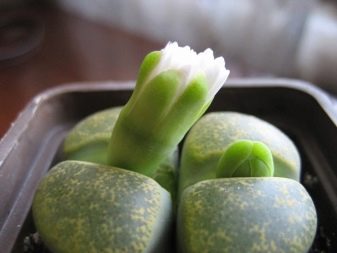
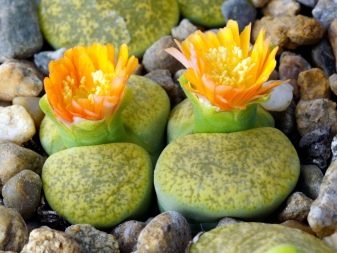
The second most popular variety of Lithops is Aucamp. It has a green, dark green or brownish-brown color with a complex pattern (sometimes there are specimens with a gray or bluish-gray color). It grows mainly in the southern regions of Africa.
Its name also comes from the surname of the discoverer of this species.
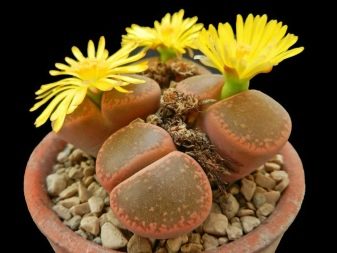

It blooms with beautiful and rather large flowers of a rich yellow color, but, unlike Leslie, its flowers have a rather weak aroma, which can be difficult even to feel. Some subspecies of this plant can bloom with flowers that have two shades: the flower can be white from the core to the middle of the petals, and from the middle to the tips of the inflorescence - bright yellow.
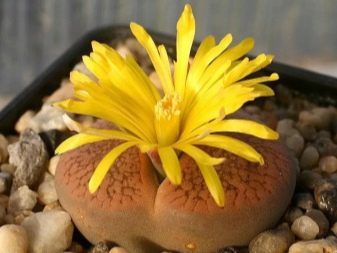
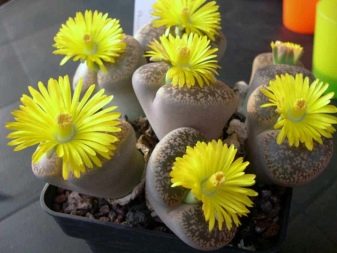
This variety of Lithops is somewhat larger than the previous one; their leaves reach 3 centimeters in diameter. In height "Aucamp" can grow up to 3-4 centimeters. When a flower blooms, its diameter can reach 4 centimeters, that is, leaves can completely hide under it. The flowering period at Aucamp, subject to all conditions for growth and favorable conditions, can occur several times per season.
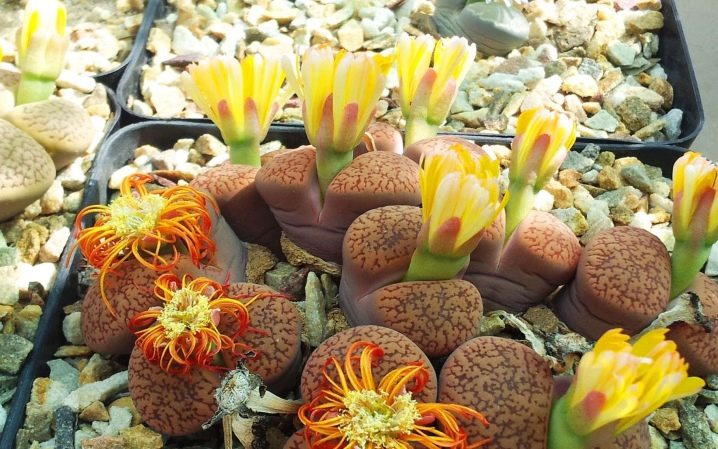
Care
If lithops initially grows in its natural habitat, then it has a growth cycle of one year. The length of each part of the cycle will depend on the length of the day, rainfall, soil conditions, ambient temperature and other natural conditions.
The content of lithops, its changes may also depend on the specific type of plant, since some varieties bloom in different periods of the year.
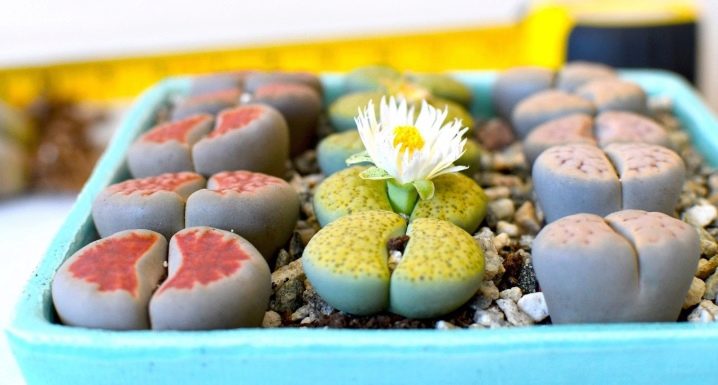
For example, if a period of sunny days comes (a period of drought for a plant), then Lithops can go into hibernation. At this time, he will not give inflorescences and grow. When the rainy season comes, lithops comes to life and first gives a flower, and a little later a fruit, which contains seeds for new flowers. After the lithops gives seeds, the plant begins to renew itself: the old leaves that have survived the flowering period gradually dry up and die. After the period of precipitation begins again, the flower begins to throw out new thick leaves, which gradually replace the old ones. After the new leaves have fully ripened, the old ones dry up completely, thin out and fall off - the plant "molt" occurs.

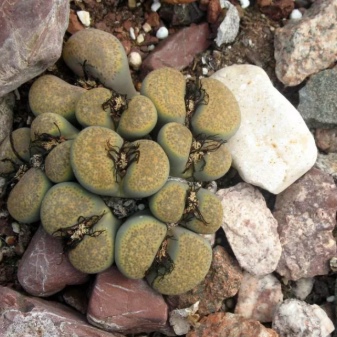
Growing lithops at home is quite possible, this plant does not require any special knowledge, it only needs attention. Everything must be done so that the conditions of its cultivation are as close as possible to natural. Watering is a very important part of plant care.
If you pour it over, the roots can rot and the plant itself can die, if you don't water it for a long time, the flower will simply go into hibernation, and if the situation is not corrected in time, it will dry out.

The beginning and middle of summer in the southern regions of Africa - the birthplace of Lithops, are usually arid. This means that the plants are adapted in such a way that at this time they have a dormant period. During these months, they may not be watered at all or watered very rarely. August and September are precipitation times, so flowers should be watered as often as possible to simulate the rainy season. But do not immediately fill the plant.The frequency of watering should be increased gradually, reaching a maximum by the end of August or the beginning of September. After that, the amount of moisture is also gradually reduced.
If done correctly, lithops will begin to bloom soon after the rainy season. Starting from the moment the inflorescence opens, watering should be stopped completely before the end of the winter months.
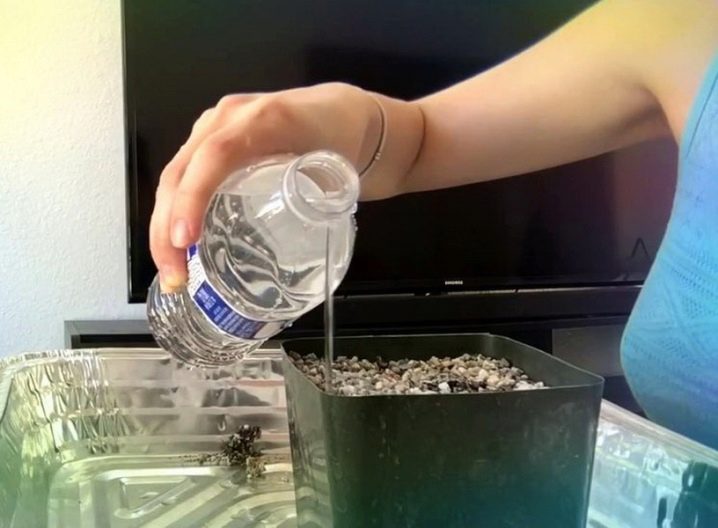
It is worth starting to restore watering from the end of March, gradually increasing it to a maximum by mid-April, and then gradually reducing it to normal (infrequent) watering by the end of May. This time is very important, since it is during these months that the plant accumulates moisture to create and grow new leaves. Several important rules for watering succulents.
- Lithops are desert plants. They do not tolerate excess moisture. The roots of the plant begin to rot from the constant moisture of the soil. Therefore, it is necessary to ensure that the soil in the plant pot is completely dry between waterings.
- These plants have very long roots. This is important to take into account not only when watering, but also when transplanting a plant. It is best to choose a deep, long pot for them. The roots are the main part that looks for water, so it is better to water the lithops through a sump or by immersion. It consists in the fact that a pot with a plant is placed in any container filled with water (you can dissolve fertilizers in it in advance). It is necessary to hold the pot until the bubbles of soil cease to come out, after which you need to take out the planter and place it on a towel or wire rack to get rid of excess moisture.
- If you do water the lithops in the usual way, then do not allow moisture to get into the space between the leaves. This can cause rot and kill the plant from the inside. For the same reason, it does not need to be sprayed. If you are worried that the air in your home is too dry, then again, remember that lithops is a desert plant, which means that it is adapted to dry air. Water the flower with heated and purified water.
- A sign that the plant does not have enough water is that large sheets begin to wrinkle and shrink. When overflowing, in addition to root rotting, the effect of a "second life" may occur for those petals that were supposed to be replaced by new ones. This prevents the plant from fully developing and worsens its appearance.
- It is recommended to water Lithops once every two weeks during the period of active growth and flowering and no more than once a month if the winter and hibernation period is too dry.
- Immersion watering is recommended after the large leaves of the plant have been renewed, as this improves the development of the roots, which are responsible for the absorption of moisture from the young petals.
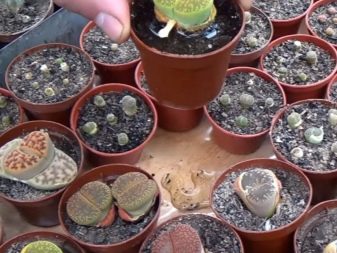
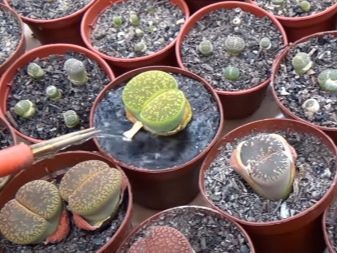
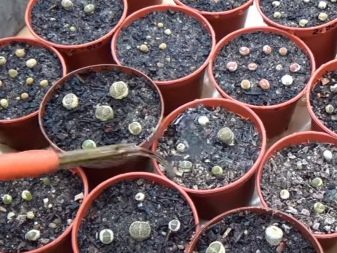
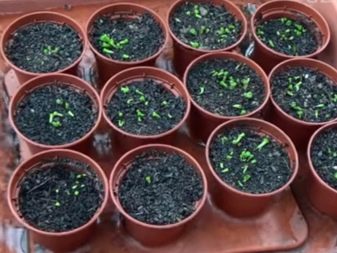
Since Lithops are native to Africa, they are not afraid of high temperatures and hot sun, but they do not tolerate cold well. It will be much easier to care for a flower if you immediately put it in the most illuminated place in the house (that is, where the maximum amount of sunlight falls). Moving or even turning the plant pot is not recommended. The consistency of position is very important for the correct formation of leaves and inflorescences. The average amount of time it takes to get the daylight rate should be about 5 hours per day. After that, you can cover the plant from the sun, creating a small partial shade, which must be removed the next day.
In our temperate climate, African flowers may lack the sun, in this case it is necessary to purchase a phytolamp and illuminate the plant additionally.

You should not arrange flowers in the back of the apartment, far from the windows (including on the north side). This can cause a lack of sunlight and rot, especially if the plant has been in an unventilated area. A sign of a lack of light is a pale coloration and elongated tops of the tips of the leaves. Leaf rot is easy to recognize, but root rot is more difficult, but they only rot in wet soil.In a pot of lithops, the soil should always be well dried.
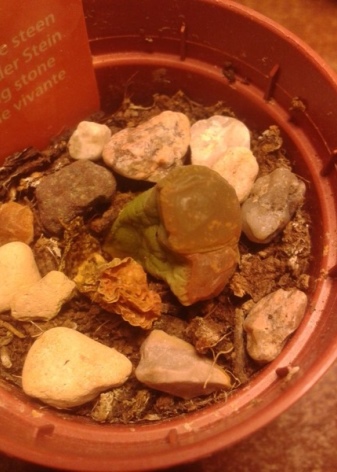
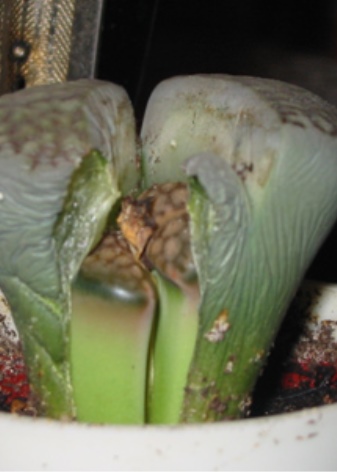
The most suitable temperature for growing flowers is around 25 degrees. It is clear that it is very difficult to maintain the same temperature all the time. In the cold season, a temperature drop of up to 17 degrees is allowed. If the temperature drops even lower, then remember that the minimum temperature at which the plant can survive is from 5 to 10 degrees.
In warmer winters, it is necessary to slightly moisten or spray the soil so that the root part of the plant does not dry out.
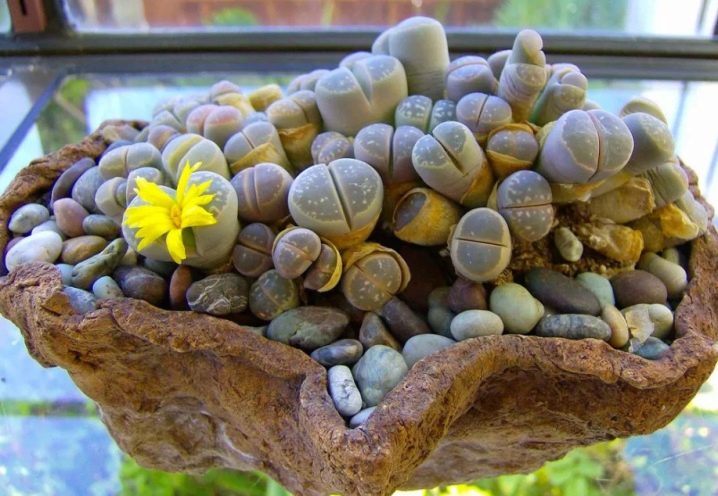
Fertilizers for these desert flowers are not essential. It is necessary to fertilize or feed these plants from spring to autumn (the most active periods of a flower's life). But these are approximate dates, since different varieties of succulents have different life cycles. It is important not to overdo it with feeding. The optimal frequency is once every 2-3 weeks.
The soil for growing a flower should not be dense, it is possible to add small pebbles like pebbles or pieces of broken brick to it. Neutral acidity is also important, otherwise the plant either does not take root immediately, or it will die over time.
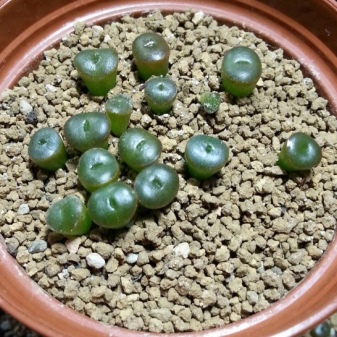

Transfer
It is recommended to replant the plant only in extreme cases. For example, if the root system has grown too much and is already difficult to fit into the pot. But this plant grows very slowly, so the transplant may not take several years, which is for the best, since this type of flowers can be transplanted every 4-5 years.
In any case, transplanting should be done only after the main leaves change (usually in spring, but the growth cycle depends on the selected plant variety).
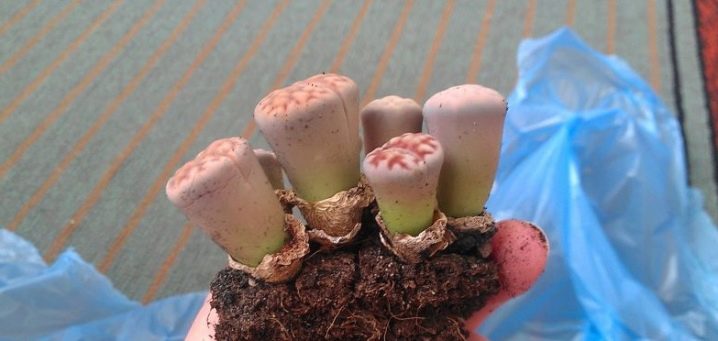
When planting in a new pot, it is necessary to take into account the peculiarities of the structure of the root and choose not a wide planter, but a long, elongated pot. If you are buying a small succulent, then it must be transplanted immediately after purchase, since store pots are very small and are not suitable for long-term presence of plants with a long developing root. In addition, pots designed for sale with plants are usually made of plastic, which is not entirely useful for seedlings.... The pot must have a drainage system through which excess moisture can flow.

The root system consists of one large root, several middle processes from it and a huge number of very small roots. The transplant should be carried out with great care, because this can damage the small processes. The plant can survive damage to the middle roots, but damage to the most basic root will simply kill the flower. The soil for transplantation and growth should be identical to that in which the flower was previously - these flowers practically cannot adapt to changing conditions of existence.
It is preferable to choose a planting mixture that contains a lot of sand, small pebbles or gravel, with which vermiculite can be used.
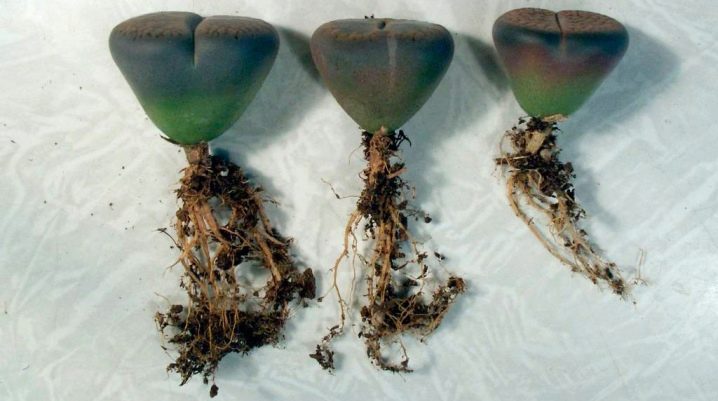
It is not necessary to buy a ready-made mixture - you can make it yourself. To do this, mix one part of peat, turf, add 1.5 parts of sand and brick chips. Ash can be added to enrich the soil with minerals.
If you choose peat bought in a store, then it must be slightly diluted with sand, ash and small fragments of broken brick. Purchased peat may turn out to be too fat and too dense for unpretentious lithops, which will somewhat complicate the process of growing them. The top layer of soil must be covered with pebbles - this will help to recreate the natural conditions for the plant, moreover, it will fit better into the interior than just blackening earth.
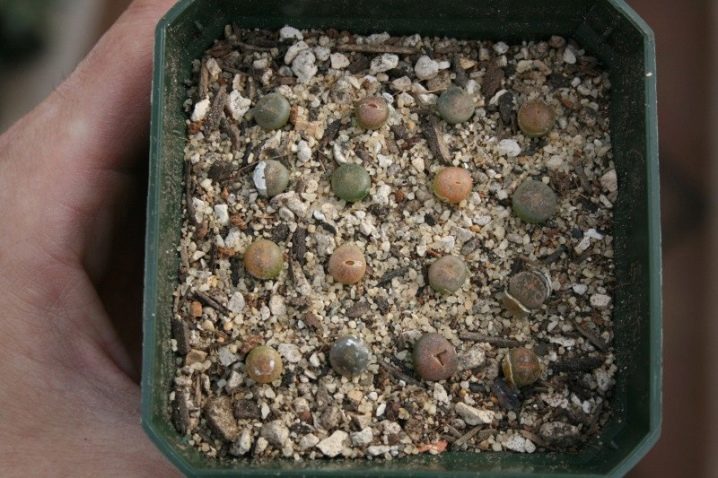
It is worth planning a transplant in advance so as not to water the plant for several days. After you have moved the lithops to a new pot, it is also worth refraining from watering in order for the flower to take root better.
There is no single answer to the question of whether it is worth combining several types of these flowers in one pot. Some researchers believe that lithops develop much better in the company of their relatives, but there is also a theory that loneliness can slow down the growth of these plants. In any case, you can check this in person by planting several flowers in one pot. If something goes wrong, you can always have them sit down.

Reproduction
It often happens that when the foliage changes, the plant sprouts not one, but two pairs of leaves. These plants reproduce vegetatively, so the appearance of a second pair of leaves also heralds the appearance of a new flower. If desired, they can be seated during transplantation. If you want to grow lithops yourself, you can try germinating them from seeds. To do this, you need to purchase seeds (buy or collect yourself) and soak in warm water for several hours. During this time, you can have time to prepare a suitable soil, which must first be slightly moistened.
The seeds can be dug into the soil a little. The optimum depth is about a millimeter.
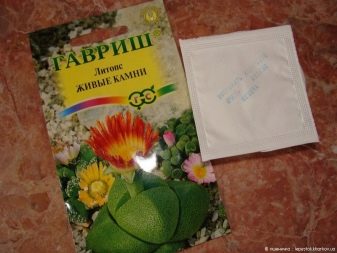

The only difficulty is the creation and maintenance of a temperature regime similar to the climate habitual for these plants. If you don't have a small glass cover at hand, then you can replace it with a regular plastic bag, which you need to cover the pot with sown soil, and then hide it from direct sunlight in a warm room. After a couple of weeks, you need to check the soil - if small swollen balls that look like bubbles appear on its surface, this means that the seeds have taken root. Now you can remove the film and start moistening the soil with a spray bottle. But you do not need to fill the seedlings - watering must be carried out as the soil dries out.
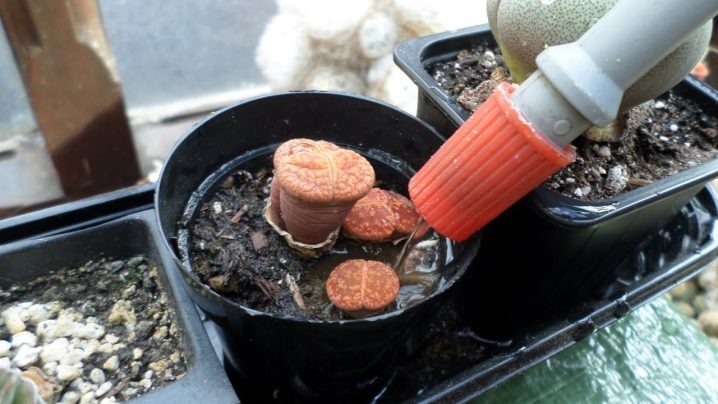
It is necessary to remove the film from the seedlings every day, since they need an influx of fresh air.
When the shoots are slightly raised above the ground, small pebbles can be scattered onto the soil surface, which will protect the ground from mold. The first planting of grown flowers should be done no earlier than a year later.
If you already have flowering lithops, then you can try to breed a new species. To do this, wait until the two flowers bloom at the same time, then carefully move the pollen from one flower to the other. To be sure, the experiment can be repeated in the opposite direction. You can use a regular paint or makeup brush to move the pollen.
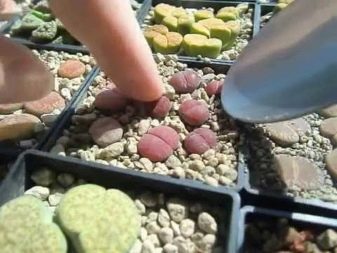
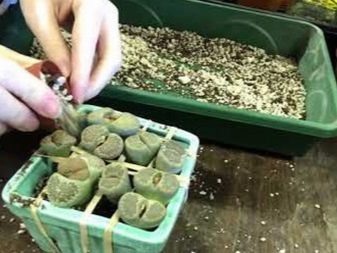
Diseases and pests
When existing in their natural environment, lithops have a fairly strong immune system that protects them from all kinds of infections. The great thing is that at home, their immune defenses are preserved, but improper care can disrupt it. It also leads to soil decay, death of the surface of the plant and the appearance of harmful insects.

The greatest danger to the plant is the mealybug, which eats up the main leaves, thereby depriving the flower of photosynthesis and moisture supply. These insects reproduce very quickly, but if there are still few of them, then you can collect them by hand, for example, with tweezers. After that, the outer part of the plant (leaves at the edges and a small trunk that raises the lithops above the ground) must be rinsed with heated water. If there are too many insect pests and they threaten to spread to other plants, then it is time to use chemicals.
To do this, you need to purchase special insecticides, for example, "Aktara", "Iskra", "Extra" and others.
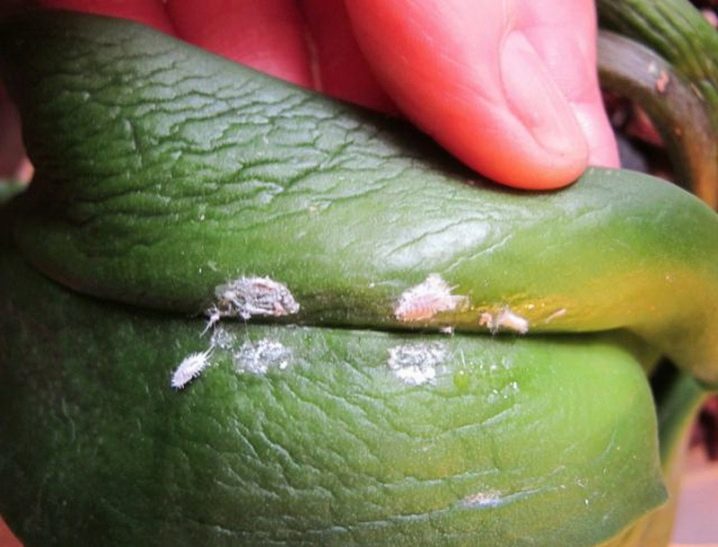
In addition, the roots can be devoured by mites. Insects can get there during the flowering period, when the plant is most vulnerable. In this case, insecticides will also help, but in order to remove the tick, it is necessary to treat the soil with them. On the days of treatment with chemicals, it is recommended to increase watering in order to remove all chemical elements from the soil as soon as possible. Otherwise, the plant may be poisoned and die.
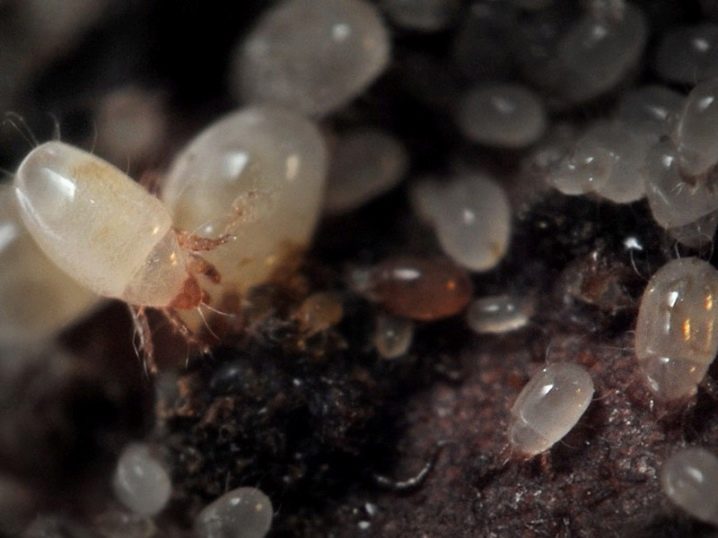
Lithops are often very resistant to infections and diseases, but if you find various spots on the leaves of the plant, then this may indicate the appearance of rot. The plant begins to rot when overflowing, in which case the root system may also suffer. To remove unpleasant consequences, it is necessary to reduce the amount of introduced moisture and dry the soil. The outer part of the plant must be treated with antifungal drugs to stop further spread of rot to the rest of the plant. If you dried the soil in a pot with a plant and treated it with a special agent against fungus, and the rot still does not go away and continues to devour healthy parts of the plant, then this means that the root system is affected.
In this case, only transplanting it into new dry soil will help.
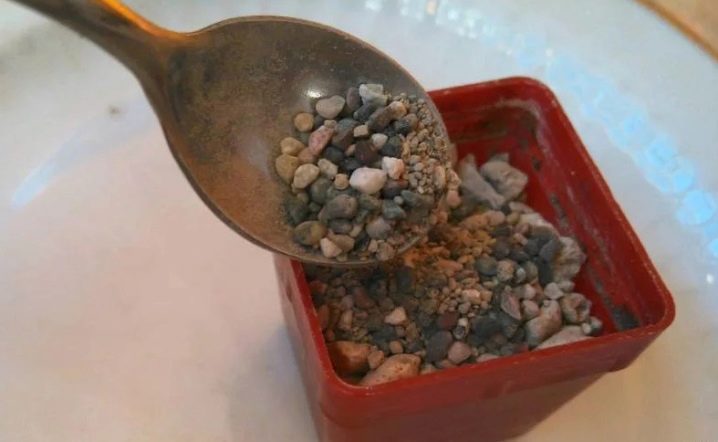
Lithops are unique and unpretentious plants, thanks to which you can create an exotic corner at home. The variety of their sizes and colors will serve as an excellent platform for the creativity of flower growers on the windowsill. The ability to breed plants with different shades of flowers is very much appreciated by hobby breeders and interior designers. After all, this makes it possible to create a piece of wild Africa right at home.
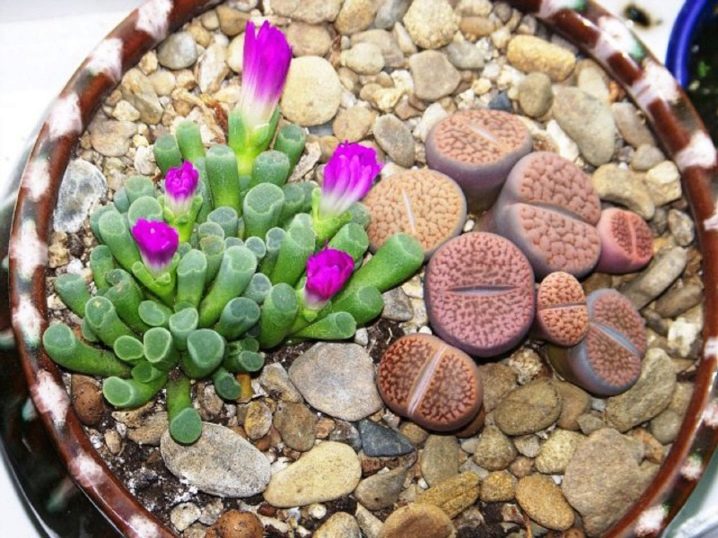
See below for more details.
















































The comment was sent successfully.